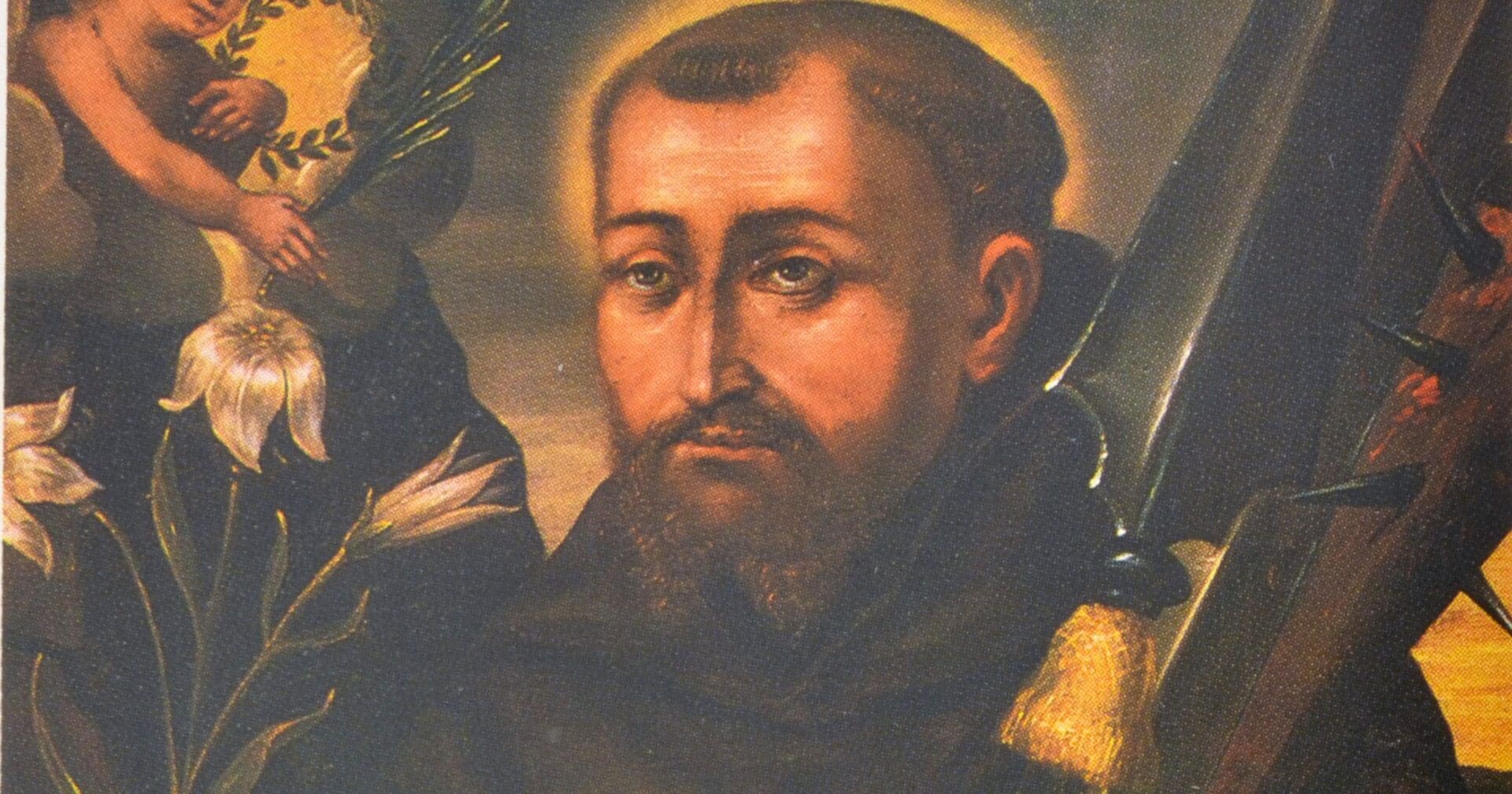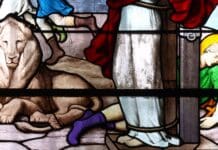Saint Fidelis of Sigmaringen was born in 1577, at Sigmaringen, Prussia, of which town his father Johannes Rey was burgomaster; died at Sevis, 24 April, 1622. On the paternal side he was of Flemish ancestry. He pursued his studies at the University of Freiburg in the Breisgau, and in 1604 became tutor to Wilhelm von Stotzingen, with whom he travelled in France and Italy. In the process for Fidelis’s canonization Wilhelm von Stotzingen bore witness to the severe mortifications his tutor practised on these journeys.
In 1611 he returned to Freiburg to take the doctorate in canon and civil law, and at once began to practise as an advocate. But the open corruption which found place in the law courts determined him to relinquish that profession and to enter the Church. He was ordained priest the following year, and immediately afterwards was received into the Order of Friars Minor of the Capuchin Reform at Freiburg, taking the name of Fidelis. He has left an interesting memorial of his novitiate and of his spiritual development at that time in a book of spiritual exercises which he wrote for himself. This work was re-edited by Father Michael Hetzenauer, O.F.M. Cap., and republished in 1893 at Stuttgart under the title: “S. Fidelis a Sigmaringen exercitia seraphicae devotionis”. From the novitiate he was sent to Constance to finish his studies in theology under Father John Baptist, a Polish friar of great repute for learning and holiness. At the conclusion of his theological studies Fidelis was appointed guardian first of the community at Rheinfelden, and afterwards at Freiburg and Feldkirch. As a preacher his burning zeal earned for him a great reputation.
From the beginning of his apostolic career he was untiring in his efforts to convert heretics nor did he confine his efforts in this direction to the pulpit, but also used his pen. He wrote many pamphlets against Calvinism and Zwinglianism though he would never put his name to his writings. Unfortunately these publications have long been lost. Fidelis was still guardian of the community at Feldkirch when in 1621 he was appointed to undertake a mission in the country of the Grisons with the purpose of bringing back that district to the Catholic Faith. The people there had almost all gone over to Calvinism, owing partly to the ignorance of the priests and their lack of zeal.
In 1614 the Bishop of Coire had requested the Capuchins to undertake missions amongst the heretics in his diocese, but it was not until 1621 that the general of the order was able to send friars there. In that year Father Ignatius of Sergamo was commissioned with several other friars to place himself at the disposal of this bishop for missionary work, and a similar commission was given to Fidelis who however still remained guardian of Feldkirche. Before setting out on this mission Fidelis was appointed by authority of the papal nuncio to reform the Benedictine monastery at Pfafers. He entered upon his new labours in the true apostolic spirit. Since he first entered the order he had constantly prayed, as he confided to a fellow-friar, for two favours: one, that he might never fall into mortal sin; the other, that he might die for the Faith. In this Spirit he now set out, ready to give his life in preaching the Faith. He took with him his crucifix, Bible, Breviary, and the book of the rule of his order; for the rest, he went in absolute poverty, trusting to Divine Providence for his daily sustenance. He arrived in Mayenfeld in time for Advent and began at once preaching and catechizing; often preaching in several places the same day. His coming aroused strong opposition and he was frequently threatened and insulted. He not only preached in the Catholic churches and in the public streets, but occasionally in the conventicles of the heretics. At Zizers one of the principal centres of his activity, he held conferences with the magistrates and chief townsmen, often far into the night. They resulted in the conversion of Rudolph de Salis, the most influential man in the town, whose public recantation was followed by many conversions.
Throughout the winter Fidelis laboured indefatigably and with such success that the heretic preachers were seriously alarmed and set themselves to inflame the people against him by representing that his mission was political rather than religious and that he was preparing the way for the subjugation of the country by the Austrians. During the Lent of 1622 he preached with especial fervour. At Easter he returned to Feldkirch to attend a chapter of the order and settle some affairs of his community. By this time the Congregation of the Propaganda had been established in Rome, and Fidelis was formally constituted by the Congregation, superior of the mission in the Grisons. He had, however, a presentiment that his laborers would shortly be brought to a close by a martyr’s death. Preaching a farewell sermon at Feldkirch he said as much. On re-entering the country of the Grisons he was met everywhere with the cry: “Death to the Capuchins!” On 24 April, being then at Grusch, he made his confession and afterwards celebrated Mass and preached. Then he set out for Sevis. On the way his companions noticed that he was particularly cheerful. At Sevis he entered the church and began to preach, but was interrupted by a sudden tumult both within and without the church. Several Austrian soldiers who were guarding the doors of the church were killed and Fidelis himself was struck. A Calvinist present offered to lead him to a place of security. Fidelis thanked the man but said his life was in the hands of God. Outside the church he was surrounded by a crowd led by the preachers who offered to save his life if he would apostatize. Fidelis replied: “I came to extirpate heresy, not to embrace it”, whereupon he was struck down. He was the first martyr of the Congregation of Propaganda. His body was afterwards taken to Feldkirch and buried in the church of his order, except his head and left arm, which were placed in the cathedral at Coire. He was beatified in 1729, and canonized in 1745. St. Fidelis is usually represented in art with a crucifix and with a wound in the head; his emblem is a bludgeon. His feast is kept on 24 April.
Editorial credit: neftali / Shutterstock.com




















To clarify: to say tha Sigmaringen is in Prussia is misleading. It is in the modern state of Baden-Württemberg in the region of Swabia. St. Fidelis was from the Principality of Hohenzollern-Sigmaringen, ruled by the Catholic Swabian branch of the Hohenzollern Dynasty. It was the Franconian Protestant Hohenzollern family that inherited the Prussian throne.
Sigmaringen was not incorporated into the political entity of Prussia until the 1800s.
More properly, Sigmaringen lies in Swabia.
Sure, this may seem of little importance. But to the German people, the different regions have had a long history of independant autonomy. Which region someone hails from says alot more than people of the modern age would think.
St. Fidelis, pray for us.
Saint Fidelis of Sigmaringen, pray for us!
St. Fidelis of Sigmaringen, pray for us.
St.Fidelis,,,,,,your everlasting Faith, is what we should adhere to!!!!!!!!! Your work for our loving God grew and filled
your Heart Mind and Body for that we are eternally Greatful!!!!!! St.Fidelis,,,,May your strength be our Strength!!!!
May,,,our Priest,,,,,who has suffered a head injury,,,,,,heal QUICKLY and leave NO trace of harm !!!!!!!!!
Thank you Jesus Christ,,,,for sending to us,,,,,,St.Fidelis, a true BELIEVER!!!!!!!!
St. Fidelis, pray for the Church and us.
Father,
you filled Saint Fidelis with the fire of your love
and gave him the privilege of dying
that the faith might live.
Let his prayers keep us firmly grounded in your love,
and help us to come to know the power of Christ’s resurrection.
Through Jesus Christ, your Son,
who lives and reigns with you
in the unity of the Holy Spirit,
one God, forever and ever.
Amen.
St Fidelis pray for the Main Street Morning Group that more people may come to meetings and that I may not become discouraged